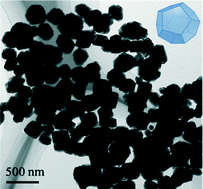An efficient precursor to synthesize various FeS2 nanostructures via a simple hydrothermal synthesis method
Abstract
Non-toxic and earth-abundant pyrite (FeS2) is a promising photoelectric material for solar energy conversion and storage. In this study, an efficient FeS precursor was employed to synthesise successfully various shapes of pyrite FeS2, such as nanopolyhedra, nanocubes, nanooctahedra, and irregular nanocrystals via a simple hydrothermal method by adjusting the reaction conditions. Pyrite FeS2 nanopolyhedra and nanocubes were synthesised using the FeS precursor as the single iron source and thiourea (NH2CSNH2) as the sulphur source at various reaction temperatures. Nanooctahedra and irregular nanocrystals were obtained using sodium thiosulfate pentahydrate (Na2S2O3·5H2O) and sulphur powder as sulphur sources. The effects of polyvinylpyrrolidone content and the molar ratio of the FeS precursor to NH2CSNH2 on the formation of cubic shaped pyrite FeS2 were investigated. The products were characterised by X-ray diffraction, scanning electron microscopy, energy-dispersive spectroscopy, transmission electron spectroscopy, X-ray photoelectron spectroscopy, and ultraviolet–visible and Raman spectroscopy. The proposed facile hydrothermal method used an efficient FeS precursor as the iron source, which can be easily controlled to produce high-purity pyrite FeS2 with desirable optical absorption properties.


 Please wait while we load your content...
Please wait while we load your content...